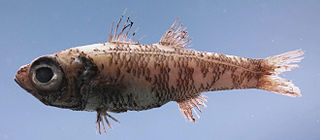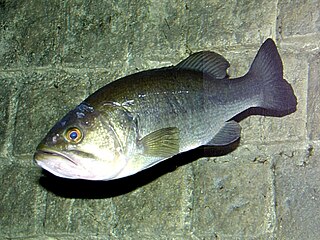
The Percidae are a family of ray-finned fish, part of the order Perciformes, which are found in fresh and brackish waters of the Northern Hemisphere. The majority are Nearctic, but there are also Palearctic species. The family contains more than 200 species in 11 genera. The perches and their relatives are in this family; well-known species include the walleye, sauger, ruffe, and three species of perch. However, small fish known as darters are also a part of this family.

The Gonostomatidae are a family of mesopelagic marine fish, commonly named bristlemouths, lightfishes, or anglemouths. It is a relatively small family, containing only eight known genera and 32 species. However, bristlemouths make up for their lack of diversity with relative abundance, numbering in the hundreds of trillions to quadrillions. The genus Cyclothone is thought to be one of the most abundant vertebrate genera in the world.

Acropomatidae is a family of ray-finned fish in the order Acropomatiformes, commonly known as lanternbellies. Acropoma species are notable for having light-emitting organs along their undersides. They are found in all temperate and tropical oceans, usually at depths of several hundred meters. There are about 32 species in as many as 9 genera, although some authorities recognise fewer genera than Fishbase does.

Triodon macropterus is a tetraodontiform fish, the only living species in the genus Triodon and family Triodontidae. Other members of the family are known from fossils stretching back to the Eocene. The threetooth puffer was first scientifically described by René Lesson in 1831 and is recognizable for its large belly flap which has the ability to blend into the body when fully retracted.

Carinotetraodon is a polyphyletic genus of small freshwater pufferfish found in South and Southeast Asia. Several species have commercial importance as aquarium fish.

The viper dogfish or viper shark is a rare species of dogfish shark in the family Etmopteridae, and the only extant member of its genus. It has been found in the Pacific Ocean off southern Japan, the Bonin Islands, Pacific Ocean off northern Taitung County and the Northwestern Hawaiian Islands. This species inhabits upper continental slopes and seamounts. It may migrate vertically, shifting between bottom waters 270–360 m (890–1,180 ft) deep during the day and upper waters less than 150 m (490 ft) deep at night. A slender, black shark reaching 54 cm (21 in) in length, the viper dogfish can be recognized by its narrow, triangular jaws and well-spaced, fang-like teeth. It also has two spined dorsal fins, dermal denticles with faceted crowns, and numerous light-emitting photophores concentrated on its ventral surface.

Gymnocephalus is a genus of ray-finned fishes from the family Percidae, which includes the perches, pike-perches and darters. They are from the Western Palearctic area, although one species, Gymnocephalus cernua has been accidentally introduced to the Great Lakes region where it is regarded as an invasive species. They have the common name "ruffe" and resemble the true perches in the genus Perca, but are usually smaller and have a different pattern.

The Microcanthinae, commonly known as footballers, mados, stripeys, and moonlighters, are a subfamily of the sea chubs, a family of marine ray-finned fish in the order Perciformes.

Epigonus is a genus of fish in the family Epigonidae found in the Atlantic, Indian and Pacific Ocean. The genus was erected by Constantine Samuel Rafinesque in 1810.

An anchovy is a small, common forage fish of the family Engraulidae. Most species are found in marine waters, but several will enter brackish water, and some in South America are restricted to fresh water.

The giant sunfish or bumphead sunfish, , is a fish belonging to the family Molidae. It is closely related to the more widely known Mola mola, and is found in the Southern Hemisphere. With a specimen found dead near the Azores in 2021 weighing in at 2744 kg it is the largest extant bony fish species in terms of maximum recorded mass by a wide margin. It can be found basking on its side occasionally near the surface, which is thought to be used to re-heat themselves after diving in cold water for prey, recharge their oxygen stores, and attract gulls to free them of parasites.

Deveximentum is a genus of ponyfishes native to the Indian Ocean and the western Pacific Ocean.

Acropoma is a genus of ray-finned fish in the family Acropomatidae, the temperate ocean-basses or lanternbellies. They are native to the Indian Ocean and western Pacific Ocean. They are characterized by a ventral luminous organ that has a luminous gland, a lens, and a reflector. The shape of the luminous organ helps distinguish the species in the genus.
The Three-spined cardinalfish is a species of ray-finned fish in the family Malakichthyidae. It is endemic to the marine waters off of Australia. Another name for this species of fish is Flathead feed.

The blackthroat seaperch, also known as the rosy seabass, is a species of ray-finned fish in the family Acropomatidae, the temperate ocean-basses or lanternbellies. It is the only species in the monotypic genus Doederleinia. It is native to the eastern Indian Ocean and the western Pacific Ocean from Japan to Australia. In Japan it is known as nodoguro or akamutsu.

Malakichthys is a genus of ray-finned fish in the family Malakichthyidae. They are native to the Indian Ocean and the western Pacific Ocean.

Verilus sordidus is a species of ray-finned fish in the family Malakichthyidae. It is native to the central western Atlantic Ocean. It is found in the waters off Cuba to Colombia and Venezuela where it is found at depths shallower than 100 metres (330 ft) over rocky bottoms.
Acropoma boholensis is a species of ray-finned fish, a lanternbelly from the family Acropomatidae which is found in the western Pacific Ocean around the Philippines.
Verilus pseudomicrolepis is a species of ray-finned fish in the family Malakichthyidae. It lives at a depth of approximately 200–600 metres and mainly inhabits the Caribbean Sea, reaching a length of around 14.5 centimetres.

Centrarchiformes is an order of ray-finned fish, previously included amongst the perciformes, with 20 families. This order first appeared about 55.8 million years ago in the Eocene Era, and is composed primarily of omnivores. The order has a wide range that includes the continents of Australia and South America. Many Centrarchiformes look essentially perch-like, featuring a stocky build and a spine-bearing dorsal fin, and range in size from 2.5 cm in length, to 1.8 meters for the Maccullochella peelii. The order Centrachiformes is not recognized in the 5th Edition (2016) of Fishes of the World, but is accepted on the World Register of Marine Species in November 2023 and Fishbase.

















